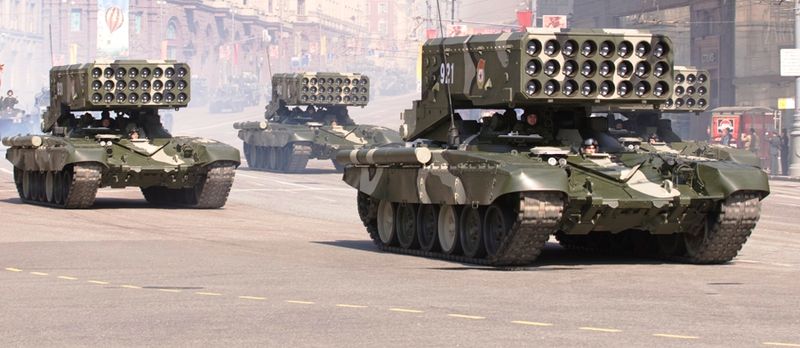 The reemergence of Russia as a traditional military power is now clear to all who wish to see. Bolstered by oil money, the Kremlin is investing seriously in defense for the first time since the collapse of the Soviet Union. Russian naval shipbuilding, which nearly disappeared in the 1990s, is now funded at half the level of the U.S. Navy’s program, while only a few years ago it was only one-tenth of the Navy’s level. Russia’s ground forces, which have been troubled for more than two decades, are now receiving serious reinvestment and are slated to add forty new brigades by 2020 (by way of comparison, the U.S. Army will be down to thirty-two active maneuver brigades by 2017, even under unduly optimistic budget scenarios).
The reemergence of Russia as a traditional military power is now clear to all who wish to see. Bolstered by oil money, the Kremlin is investing seriously in defense for the first time since the collapse of the Soviet Union. Russian naval shipbuilding, which nearly disappeared in the 1990s, is now funded at half the level of the U.S. Navy’s program, while only a few years ago it was only one-tenth of the Navy’s level. Russia’s ground forces, which have been troubled for more than two decades, are now receiving serious reinvestment and are slated to add forty new brigades by 2020 (by way of comparison, the U.S. Army will be down to thirty-two active maneuver brigades by 2017, even under unduly optimistic budget scenarios).
All this has been noticed by the NATO member countries located close to Russia, many of which were unnerved by Moscow’s recent Zapad (West) military exercises which, despite their portrayal by the Kremlin as a counterterrorism practice run, were clearly more conventional in focus and, given their location—and name—plus the involvement of Belarusian forces in the exercise, proved troubling to frontline NATO states, above all Poland and the Baltic states.
NATO’s Baltic members are accustomed to regular harassment by Moscow, with aggressive espionage, subversion, and manipulation of local politics, business, and Russian minorities being part of daily life in Estonia, Latvia, and Lithuania. Russian intelligence services are highly active in the Baltics and generally treat them as less than sovereign states, much less NATO member countries. But the return of a conventional military threat from Russia, coupled with press releases from Vladimir Putin’s Kremlin that seem nostalgic for the Soviet period, has led to a mounting sense of dread in the Baltics.
Poland’s response here has been significant, as it is the largest and most important NATO frontline state in terms of military, political and economic power. Warsaw of late has been trying to raise Alliance awareness of the rising threat from the East, but this has been met with skepticism by NATO members located farther to the West than Poland. In a typical example, the expression of current Alliance assumptions by NATO secretary general Anders Fogh Rasmussen that “war among European nations is simply unimaginable,” was countered in May by the statement of Poland’s Foreign Minister Radek Sikorski: “I’m afraid conflict in Europe is imaginable. . . .”
In addition to the Kremlin’s military buildup, recent Russian actions towards Ukraine, a buffer state that Poland considers vital to its security, have been ominous. As Ukraine’s government, led by the pro-Russian president Viktor Yanukovych, has seemed to favor closer economic ties to the European Union, at the expense of more engagement with Putin’s proposed Eurasian Union, the rhetoric from Moscow has heated up, culminating in an unambiguous threat to Ukraine’s territorial integrity. Last month, in language reminiscent of that used by Milosevic’s Serbia in the early 1990s, Sergei Glazyev, a top Kremlin adviser, noted that Russia has threatened to support a partitioning of Ukraine if it signs a landmark cooperation agreement with the European Union, adding that if certain regions of Ukraine where ethnic Russians live did not wish to join the EU, Moscow “would be legally entitled” to support them. It is abundantly clear that, for Putin’s Kremlin, anything less than a satellite in Kiev is unacceptable, a development that has major implications for NATO and the EU, as well as European security, not least because Ukraine is a pivotal state that is divided right along the fault lines cited by Samuel Huntington in his famous “Clash of Civilizations.” What happens to Ukraine in the near future will set the course for all of East-Central Europe in the decades ahead, and Poland knows this. . . .
[I]t’s clear that the era when NATO can assume there are few, if any, conventional threats to the Alliance in Europe is at an end. NATO will either accept this challenge to deter Russian aggression and manipulation of frontline states like Poland and the Baltics through readiness and vigilance, or the most successful alliance in history will have lost its purpose. Given the Pentagon’s grim budgetary realities, that burden will have to be borne more by European states than by the United States, but Poland has shown the way with its new strategy and increased defense spending. Others must now follow Warsaw’s lead. After a two-decade holiday, history has returned to Europe.
John R. Schindler is professor of national security affairs at the Naval War College and a former National Security Agency analyst. The views expressed here are his own. He blogs at 20committee.com.
Image: Russian TOS-1 30-barrel multiple rocket launchers (photo: Aleksey Toritsyn/Wikipedia)
